1) Which of the following sequences correctly represents the flow of electrons during photosynthesis?
A. H2O > NADPH > Calvin Cycle
B. NADPH > Chlorophyll > Calvin Cycle
C. NADPH > Electron transport chain > O2
D. NADPH > O2 > CO2
E. H20 > Photosystem 1 > Photosystem 2
A
2) Photosynthesis is a redox reaction. This means that H2O is _____ during the light reactions and CO2 is _____ during the Calvin cycle.
A. Oxidized ... Reduced
B. Reduced ... Reduced
C. Consumed ... Consumed
D. Consumed ... Reduced
E. Reduced ... Oxidized
A
3)What is the basic role of CO2 in photosynthesis?
A. CO2 is fixed or incorporated into organic molecules.
B. CO2 is taken in by plants as a form of inverse respiration, in which carbon dioxide is “breathed in” and oxygen is “breathed out.”
C. CO2 is a source of electrons in the formation of organic molecules.
D. O2
E. C08
A
4)Which of the following is a product of the light reactions of photosynthesis?
A. Glyceraldehyde-3-phosphate
B. High-energy photons
C. Oxygen, ATP, and NADPH
D. NADP+ and RuBP
E. Water and CO2
C
5)When light strikes chlorophyll molecules, they lose electrons, which are ultimately replaced by _____.
A. Oxidizing glucose
B. Fixing carbon
C. Splitting water
D. Breaking down ATP
E. Removing them from NADPH
C
6)C4 plants occur more commonly in desert conditions because _____.
A. They store carbon by incorporating CO2 into organic acids that are later catabolized
B. They produce water as a product of their photosynthetic pathways
C. The stomata open at night and close in the day
D. They can fix carbon at the lower CO2 concentrations that develop when the stomata are closed
E. They produce carbon dioxide internally via photorespiration
D
7)Carbon fixation involves the addition of carbon dioxide to _____.
A. Rubisco
B. G3P
C. NADPH
D. RuBP
E. 3-PGA
D
8)After 3-PGA is phosphorylated, it is reduced by _____.
A. CO2
B. NADPH
C. ATP
D. ADP
E. NADP+
B
9)How many carbon dioxide molecules must be added to RuBP to make a single molecule of glucose?
A. 6
B. 2
C. 10
D. 4
E. 8
A
10)In the Calvin cycle, how many ATP molecules are required to regenerate RuBP from five G3P molecules?
A. 1
B. 3
C. 2
D. 4
E. 5
B
11)Which term describes ATP production resulting from the capture of light energy by chlorophyll?
A. Substrate-level phosphorylation
B. Photophosphorylation
C. Dephosphorylation
D. Oxidative phosphorylation
B
12)True or false? The chemiosmotic hypothesis states that the synthesis of ATP generates a proton gradient that leads to electron flow through an electron transport chain.
A. TRUE
B. FALSE
C. Dephosphorylation
D. Oxidative phosphorylation
E. C02
B
13)According to the chemiosmotic hypothesis, what provides the energy that directly drives ATP synthesis?
A. Temperature gradient
B. Osmotic gradient
C. Electrons
D. Proton gradient
D
14)Which of the following particles can pass through the ATP synthase channel?
A. ATP
B. ADP
C. Inorganic phosphate
D. Protons
D
15)True or false? The region of ATP synthase that catalyzes the production of ATP from ADP and inorganic phosphate spans the chloroplast membrane.
A. True
B. False
C. Inorganic phosphate
D. Protons
E. C02
B
16)Chloroplast membrane vesicles are equilibrated in a simple solution of pH 5. The solution is then adjusted to pH 8. Which of the following conclusions can be drawn from these experimental conditions?
A. ATP will be produced because the proton gradient favors proton movement through the ATP synthase channels.
B. ATP will not be produced because there is no ADP and inorganic phosphate in the solution.
C. The change in the solution's pH results in a gradient across the chloroplast membranes such that there is a lower concentration of protons inside the vesicles and a higher concentration outside.
D. Protons will not diffuse toward the outside of the vesicles.
B
17)_____ has a longer wavelength than _____.
A. Yellow ... red
B. Red ... green
C. Violet ... blue
D. Green ... yellow
E. Blue ... green
B
18)The overall function of the Calvin cycle is _____.
A. Making sugar
B. Producing carbon dioxide
C. Capturing sunlight
D. Splitting water
E. Oxidizing glucose
A
19)In mechanism, photophosphorylation is most similar to
A. Reduction of NADP+.
B. Carbon fixation.
C. The Calvin cycle.
D. Oxidative phosphorylation in cellular respiration.
E. Substrate-level phosphorylation in glycolysis.
D
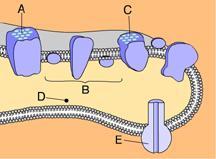
20)Which of these phosphorylates ADP to make ATP?
a. A
b. D
c. E
d. C
e. B
C
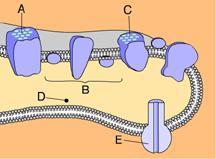
21)_____ releases energy that is used to pump hydrogen ions from the stroma into the thylakoid compartment.
A. E
B. C
C. B
D. D
E. A
C

22)_____ splits water into 1/2 O2, H+, and e- .
A. B
B. C
C. A
D. E
E. D
C

23)Energized electrons from ____ enter an electron transport chain and are then used to reduce NADP+.
A. B
B. E
C. A
D. C
E. D
D

24)Chlorophyll can be found in _____.
A. B and C
B. A and C
C. A and B
D. B and D
E. B and E
B
25)Which of these equations best summarizes photosynthesis?
A. C6H12O6 + 6 O2 → 6 CO2 + 12 H2O
B. H2O → 2 H+ + 1/2 O2 + 2e-
C. 6 CO2 + 6 H2O → C6H12O6 + 6 O2
D. 6 CO2 + 6 O2 → C6H12O6 + 6 H2O
E. C6H12O6 + 6 O2 → 6 CO2 + 6 H2O + Energy
C
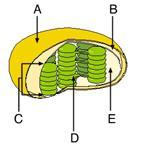
26)Where does the Calvin cycle occur?
A. C
B. E
C. D
D. B
E. A
B
27)The light reactions of photosynthesis use _____ and produce _____.
A. Water ... NADPH
B. NADPH ... oxygen
C. Carbon dioxide ... oxygen
D. NADPH ... NADP+
E. Carbon dioxide ... sugar
A
28)Select the correct molecule that is the main product of the Calvin cycle.
A. G3P
B. NADPH
C. Glucose
D. O2
E. C02
A
29)In C3 plants the conservation of water promotes _____.
A. A shift to C4 photosynthesis
B. The light reactions
C. The opening of stomata
D. Photosynthesis
E. Photorespiration
E
30)In C4 and CAM plants carbon dioxide is fixed in the _____ of mesophyll cells.
A. Grana
B. Thylakoids
C. Cytoplasm
D. Stomata
E. Stroma
C
31) C4 plants differ from C3 and CAM plants in that C4 plants _____.
A. Use malic acid to transfer carbon dioxide to the Calvin cycle
B. Transfer fixed carbon dioxide to cells in which the Calvin cycle occurs
C. Are better adapted to wet conditions
D. Open their stomata only at night
E. Use PEP carboxylase to fix carbon dioxide
B
32)How is photosynthesis similar in C4 plants and CAM plants?
A. In both cases, rubisco is not used to fix carbon initially.
B. Both types of plants make sugar without the Calvin cycle.
C. In both cases, only photosystem I is used.
D. Both types of plants make most of their sugar in the dark.
E. In both cases, thylakoids are not involved in photosynthesis.
A
33) The process of photosynthesis probably originated _____.
A) in plants
B) in prokaryotes
C) in fungi
D) three separate times during evolution
B
34) In autotrophic bacteria, where is chlorophyll located?
A) in chloroplast membranes
B) in the ribosomes
C) in
the nucleoid
D) in the infolded plasma membrane
D
35) Plants photosynthesize _____.
A) only in the light but
respire only in the dark
B) only in the dark but respire only in the light
C) only in the light but respire in light and dark
D) and respire only in the light
C
36)Early investigators thought the oxygen produced by photosynthetic
plants came from carbon dioxide. In fact, it comes from _____.
A)
water
B) glucose
C) air
D) electrons from NADPH
A
37) If photosynthesizing green algae are provided with CO2 containing heavy oxygen (18O), later analysis will show that all of the following molecules produced by the algae contain 18O EXCEPT _____.
A) glyceraldehyde 3-phosphate (G3P)
B) glucose
C) ribulose bisphosphate (RuBP)
D) O2
D
38) Every ecosystem must have _____.
A) autotrophs and heterotrophs
B) producers and primary consumers
C) photosynthesizers
D) autotrophs
D
39) When oxygen is released as a result of photosynthesis, it is a direct by-product of _____.
A) splitting water molecules
B) chemiosmosis
C) the
electron transfer system of photosystem I
D) the electron transfer system of photosystem II
A
40) Which of the following statements is a correct distinction
between autotrophs and heterotrophs?
A) Cellular respiration is
unique to heterotrophs.
B) Only heterotrophs have mitochondria.
C) Autotrophs, but not heterotrophs, can nourish themselves beginning with CO2 and other
nutrients that are inorganic.
D) Only heterotrophs require oxygen.
C
41) Theodor W. Engelmann illuminated a filament of algae with light that passed through a prism, thus exposing different segments of algae to different wavelengths of light. He added aerobic bacteria and then noted in which areas the bacteria congregated. He noted that the largest groups were found in the areas illuminated by the red and blue light.
What did Engelmann conclude about the congregation of bacteria in the red and blue areas?
A) Bacteria congregated in these areas due to an increase in the
temperature of the red and blue light.
B) Bacteria congregated in
these areas because these areas had the most oxygen being released.
C) Bacteria are attracted to red and blue light and thus these wavelengths are more reactive than other wavelengths.
D) Bacteria congregated in these areas due to an increase in the temperature caused by an increase in photosynthesis.
B
42) Theodor W. Engelmann illuminated a filament of algae with light that passed through a prism, thus exposing different segments of algae to different wavelengths of light. He added aerobic bacteria and then noted in which areas the bacteria congregated. He noted that the largest groups were found in the areas illuminated by the red and blue light.
An outcome of Engelmann's experiment was to help determine the
relationship between _____.
A) wavelengths of light and the rate
of aerobic respiration
B) wavelengths of light and the amount of
heat released
C) wavelengths of light and the rate of photosynthesis
D)
the concentration of carbon dioxide and the rate of photosynthesis
C
43) A spaceship is designed to support animal life for a multiyear voyage to the outer planets of the solar system. Plants will be grown to provide oxygen and to recycle carbon dioxide. Since the spaceship will be too far from the sun for photosynthesis, an artificial light source will be needed.
What wavelengths of light should be used to maximize plant growth
with a minimum of energy expenditure?
A) full-spectrum white
light
B) green light
C) a mixture of blue and red light
D) UV light
C
44) A spaceship is designed to support animal life for a multiyear voyage to the outer planets of the solar system. Plants will be grown to provide oxygen and to recycle carbon dioxide. Since the spaceship will be too far from the sun for photosynthesis, an artificial light source will be needed.
Suppose a plant has a unique photosynthetic pigment and the leaves
of this plant appear to be reddish yellow. What wavelengths of visible
light are absorbed by this pigment?
A) red and yellow
B)
blue and violet
C) green and yellow
D) blue, green, and red
B
45) Halobacterium has a photosynthetic membrane that appears purple. Its photosynthetic action spectrum is the inverse of the action spectrum for green plants. (That is, the Halobacterium action spectrum has a peak where the green plant action spectrum has a trough.) What wavelengths of light do the Halobacterium photosynthetic pigments absorb?
A) red and yellow
B) blue, green, and red
C) green and
yellow
D) blue and red
C
46) Why are there several structurally different pigments in the
reaction centers of photosystems?
A) Excited electrons must pass
through several pigments before they can be transferred to electron
acceptors of the electron transport chain.
B) This arrangement
enables the plant to absorb light energy of a variety of
wavelengths.
C) They enable the plant to absorb more photons from
light energy, all of which are at the same wavelength.
D) They
enable the reaction center to excite electrons to a higher energy level.
B
47) If pigments from a particular species of plant are extracted and
subjected to paper chromatography, which of the following is most
likely?
A) Paper chromatography for the plant would isolate a
single band of pigment that is characteristic of that particular plant.
B) Paper chromatography would separate the pigments from a particular plant into several bands.
C) The isolated pigments would be some shade of green.
D)
Paper chromatography would isolate only the pigments that reflect
green light.
B
48) In autumn, the leaves of deciduous trees change colors. This is
because chlorophyll is degraded and _____.
A) carotenoids and
other pigments are still present in the leaves
B) the degraded
chlorophyll changes into many other colors
C) water supply to the leaves has been reduced
D) sugars are
sent to most of the cells of the leaves
A
49) What event accompanies energy absorption by chlorophyll (or other
pigment molecules of the antenna complex)?
A) ATP is synthesized
from the energy absorbed.
B) A carboxylation reaction of the
Calvin cycle occurs.
C) Electrons are stripped from NADPH.
D) An electron is excited.
D
50) The final electron acceptor associated with photosystem I is _____.
A) oxygen
B) water
C) NADP
D) NADPH
C
51) The electrons of photosystem II are excited and transferred to
electron carriers. From which molecule or structure do the photosystem
II replacement electrons come?
A) the electron carrier,
plastocyanin
B) photosystem I
C) water
D) oxygen
C
52) In the thylakoid membranes, the pigment molecules in a light-harvesting complex _____.
A) split water and release oxygen from the reaction-center
chlorophyll
B) absorb and transfer light energy to the
reaction-center chlorophyll
C) synthesize ATP from ADP and
Pi
D) transfer electrons to ferredoxin and then NADPH
B
53) Which of the following are directly associated with photosystem
I?
A) receiving electrons from the thylakoid membrane electron
transport chain
B) generation of molecular oxygen
C) extraction of hydrogen
electrons from the splitting of water
D) passing electrons to the
cytochrome complex
A
54) Some photosynthetic organisms contain chloroplasts that lack photosystem II, yet are able to survive. The best way to detect the lack of photosystem II in these organisms would be to _____.
A) determine if they have thylakoids in the chloroplasts
B)
test for liberation of O2 in the light
C) test for CO2 fixation in the dark
D) do experiments to
generate an action spectrum
B
55) What are the products of linear electron flow?
A) heat and fluorescence
B) ATP and P700
C) ATP and NADPH
D) ADP and NADP+
C
56) As a research scientist, you measure the amount of ATP and NADPH
consumed by the Calvin cycle in 1 hour. You find that 30,000 molecules
of ATP were consumed, but only 20,000 molecules of NADPH were
consumed. Where did the extra ATP molecules come from?
A)
photosystem II
B) photosystem I
C) cyclic electron
flow
D) linear electron flow
C
57) Assume a thylakoid is somehow punctured so that the interior of
the thylakoid is no longer separated from the stroma. This damage will
most directly affect the _____.
A) splitting of water
B)
flow of electrons from photosystem II to photosystem I
C) synthesis of ATP
D) reduction of NADP+
C
58) In a plant cell, where are the ATP synthase complexes located? A)
thylakoid membrane only
B) inner mitochondrial membrane
only
C) thylakoid membrane and inner mitochondrial membrane
D) thylakoid membrane and plasma membrane
C
59) In mitochondria, chemiosmosis moves protons from the matrix into
the intermembrane space, whereas in chloroplasts, chemiosmosis moves
protons from the _____.
A) matrix to the stroma
B) stroma to
the thylakoid space
C) intermembrane space to the matrix
D) thylakoid space to the stroma
B
60) Which of the following statements best describes the relationship
between photosynthesis and respiration?
A) Respiration runs the
biochemical pathways of photosynthesis in reverse.
B)
Photosynthesis stores energy in complex organic molecules; respiration
releases energy from complex organic molecules
C) Photosynthesis occurs only in plants; respiration occurs only in animals.
D) Photosynthesis is catabolic; respiration is anabolic.
B
61) In photosynthetic cells, synthesis of ATP by the chemiosmotic
mechanism occurs during _____.
A) photosynthesis only
B)
respiration only
C) photosynthesis and respiration
D) neither photosynthesis
nor respiration
C
62) Carbon dioxide is split to form oxygen gas and carbon compounds _____.
A) during photosynthesis
B) during respiration
C) during
photosynthesis and respiration
D) in neither photosynthesis nor respiration
D
63) What is the relationship between the wavelength of light and the
quantity of energy per photon?
A) They have a direct, linear
relationship.
B) They are inversely related.
C) They are logarithmically related.
D) They are separate phenomena.
B
64) P680+ is said to be the strongest biological oxidizing agent.
Given its function, why is this necessary?
A) It is the receptor
for the most excited electron in either photosystem of
photosynthesis.
B) It is the molecule that transfers electrons to
plastoquinone (Pq) of the electron transfer system.
C) It transfers its electrons to reduce NADP+ to NADPH.
D) It
obtains electrons from the oxygen atom in a water molecule, so it must
have a stronger attraction for electrons than oxygen has.
D
65) Carotenoids are often found in foods that are considered to have
antioxidant properties in human nutrition. What related function do
they have in plants?
A) They serve as accessory pigments to
increase light absorption.
B) They protect against oxidative
damage from excessive light energy.
C) They shield the sensitive chromosomes of the plant from harmful ultraviolet radiation.
D) They reflect orange light and enhance red light absorption by chlorophyll.
D
66) In a plant, the reactions that produce molecular oxygen (O2) take place in _____.
A) the light reactions alone
B) the Calvin cycle alone
C)
the light reactions and the Calvin cycle
D) neither the light
reactions nor the Calvin cycle
A
67) The accumulation of free oxygen in Earth's atmosphere began with the origin of _____.
A) life and respiratory metabolism
B) cyanobacteria using
photosystem II
C) chloroplasts in photosynthetic eukaryotic algae
D) land plants
B
68) In its mechanism, photophosphorylation is most similar to _____.
A) substrate-level phosphorylation in glycolysis
B) oxidative
phosphorylation in cellular respiration
C) the Calvin cycle
D) reduction of NADP+
B
69) Which process is most directly driven by light energy?
A)
creation of a pH gradient by pumping protons across the thylakoid membrane
B) carbon fixation in the stroma
C) reduction of NADP+ molecules
D) removal of electrons from
chlorophyll molecules
D
70) A gardener is concerned that her greenhouse is getting too hot from too much light and seeks to shade her plants with colored translucent plastic sheets, the color of which allows passage of only that wavelength. What color should she use to reduce overall light energy but still maximize plant growth?
A) green
B) blue
C) orange
D) Any color will work
equally well.
B
71) A flask containing photosynthetic green algae and a control flask containing water with no algae are both placed under a bank of lights, which are set to cycle between 12 hours of light and 12 hours of dark. The dissolved oxygen concentrations in both flasks are monitored. Predict what the relative dissolved oxygen concentrations will be in the flask with algae compared to the control flask. The dissolved oxygen in the flask with algae will _____.
A) always be higher
B) always be lower
C) be higher in the
light, but the same in the dark
D) be higher in the light, but lower in the dark
D
72) Which of the following are products of the light reactions of
photosynthesis that are utilized in the Calvin cycle?
A) CO2 and glucose
B) H2O and O2
C) ADP, Pi, and NADP+
D) ATP and NADPH
D
73) Where does the Calvin cycle take place?
A) stroma of the chloroplast
B) thylakoid membrane
C)
interior of the thylakoid (thylakoid space) D) outer membrane of the chloroplast
A
74) What is the primary function of the Calvin cycle?
A) use NADPH to release carbon dioxide
B) split water and
release oxygen
C) transport RuBP out of the chloroplast
D) synthesize simple sugars from carbon dioxide
D
75) In the process of carbon fixation, RuBP attaches a CO2 to produce a six-carbon molecule,
which is then split to produce two molecules of 3-phosphoglycerate.
After phosphorylation and reduction produces glyceraldehyde
3-phosphate (G3P), what more needs to happen to complete the Calvin
cycle?
A) addition of a pair of electrons from NADPH
B) regeneration of ATP from ADP
C) regeneration of RuBP
D) regeneration of NADP+
C
76) Which of the following sequences correctly represents the flow of
electrons during photosynthesis?
A) NADPH → O2 → C O2
B) H2O
→ NADPH → Calvin cycle
C) NADPH → chlorophyll → Calvin cycle
D) NADPH → electron
transport chain → O2
B
77) Which of the following does NOT occur during the Calvin cycle?
A) oxidation of NADPH
B) release of oxygen
C) regeneration
of the CO2 acceptor
D) consumption of ATP
B
78) What compound provides the reducing power for Calvin cycle reactions?
A) ATP
B) NADH
C) NADP+
D) NADPH
D
79) What would be the expected effect on plants if the atmospheric CO2 concentration was doubled?
A) All plants would experience increased rates of
photosynthesis.
B) C3 plants would have faster growth; C4 plants
would be minimally affected.
C) C4 plants would have faster growth; C3 plants would be minimally affected.
D) C3 plants would have faster growth; C4 plants would have slower growth.
B
80) Why are C4 plants able to photosynthesize with no apparent photorespiration?
A) They do not participate in the Calvin cycle.
B) They use PEP
carboxylase to initially fix CO2.
C) They conserve water more efficiently.
D) They exclude oxygen
from their tissues.
B
81) CAM plants keep stomata closed in the daytime, thus reducing loss
of water. They can do this because they _____.
A) fix CO2 into
organic acids during the night
B) fix CO2 into sugars in the
bundle-sheath cells
C) fix CO2 into pyruvate in the mesophyll cells
D) use photosystem I and photosystem II at night
A
82) The alternative pathways of photosynthesis using the C4 or CAM systems are said to be compromises. Why?
A) Each one minimizes both water loss and rate of
photosynthesis.
B) C4 compromises on water loss and CAM
compromises on photorespiration.
C) Both minimize photorespiration but expend more ATP during
carbon fixation.
D) CAM plants allow more water loss, while C4
plants allow less CO2 into the plant.
C
83) If plant gene alterations cause plants to be deficient in
photorespiration, what would most probably occur?
A)
Photosynthetic efficiency would be reduced at low light
intensities.
B) Cells would carry on the Calvin cycle at a much
slower rate.
C) There would be more light-induced damage to the cells.
D) Less oxygen would be produced.
C
84) Compared to C3 plants, C4 plants _____.
A) can continue to
fix CO2 even at lower CO2 concentrations and higher oxygen concentrations
B) have higher rates of photorespiration
C) do not use rubisco
for carbon fixation
D) make a four-carbon compound, oxaloacetate,
which is then delivered to the citric acid cycle in mitochondria
A
85) Photorespiration _____.
A) generates carbon dioxide and
consumes ATP and oxygen
B) generates ATP and sugars and consumes
oxygen and carbon dioxide
C) generates oxygen and consumes ATP, carbon dioxide, and sugars
D) consumes carbon dioxide and generates ATP, sugars, and oxygen
A
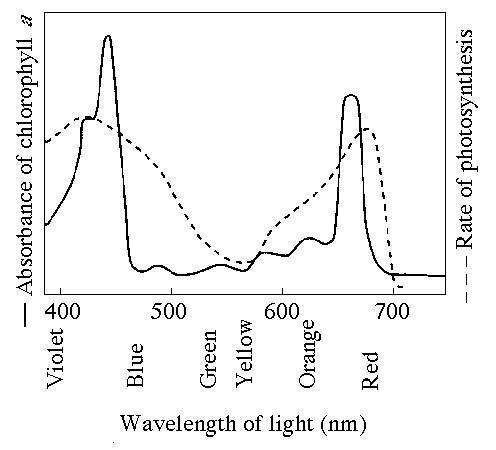
86) The figure shows the absorption spectrum for chlorophyll a and the action spectrum for photosynthesis. Why are they different?
A) Green and yellow wavelengths inhibit the absorption of red and blue wavelengths.
B) Oxygen given off during photosynthesis interferes with the absorption of light.
C) Other pigments absorb light in addition to chlorophyll a.
D) Aerobic bacteria take up oxygen, which changes the measurement of the rate of photosynthesis.
C

87) What wavelength of light in the figure is most effective in driving photosynthesis?
A) 420 mm
B) 575 mm
C) 625 mm
D) 730 mm
A
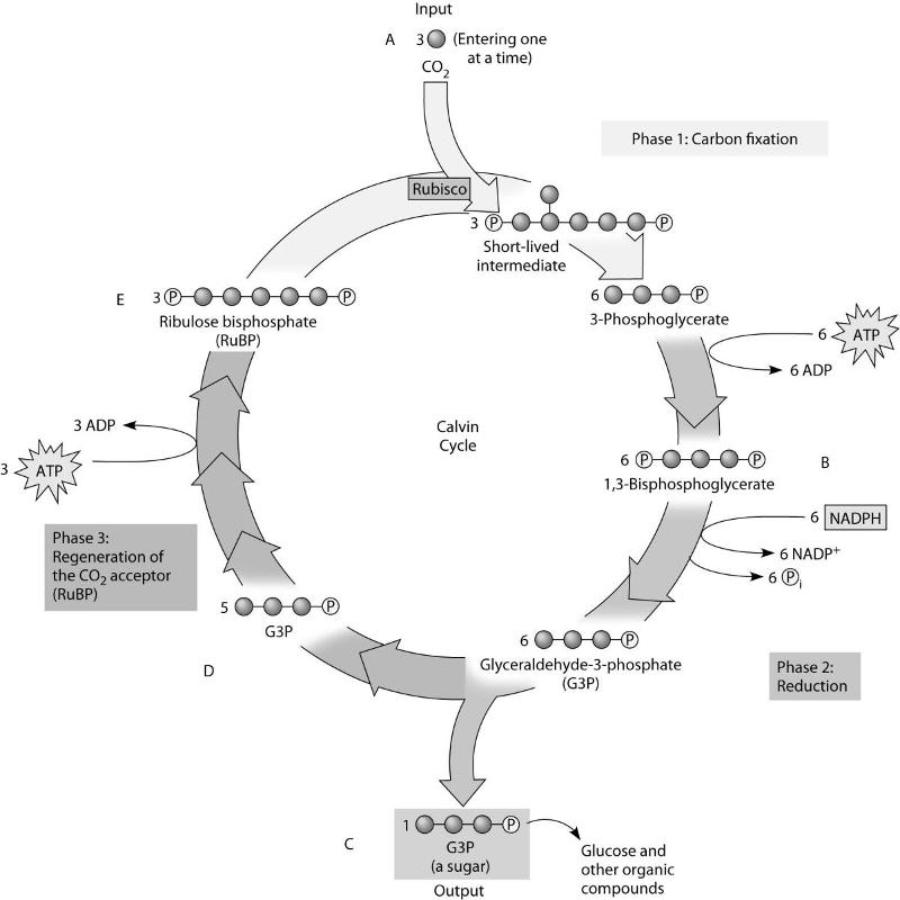
88) Refer to the figure. If the carbon atom of each of the incoming CO2 molecules is labeled with a radioactive isotope of carbon, which organic molecules will be radioactively labeled after one cycle?
A) C only
B) B, C, D, and E
C) C, D, and E only
D) B and C only
B

89) Refer to the figure. To identify the molecule that accepts CO2, Calvin and Benson manipulated the carbon-fixation cycle by either cutting off CO2 or cutting off light from cultures of photosynthetic algae. They then measured the concentrations of various metabolites immediately following the manipulation. How would these experiments help identify the CO2 acceptor?
A) The CO2 acceptor concentration would decrease when either the CO2 or light are cut off.
B) The CO2 acceptor concentration would increase when either the CO2 or light are cut off.
C) The CO2 acceptor concentration would increase when the CO2 is cut off, but decrease when the light is cut off.
D) The CO2 acceptor concentration would decrease when the CO2 is cut off, but increase when the light is cut off.
C
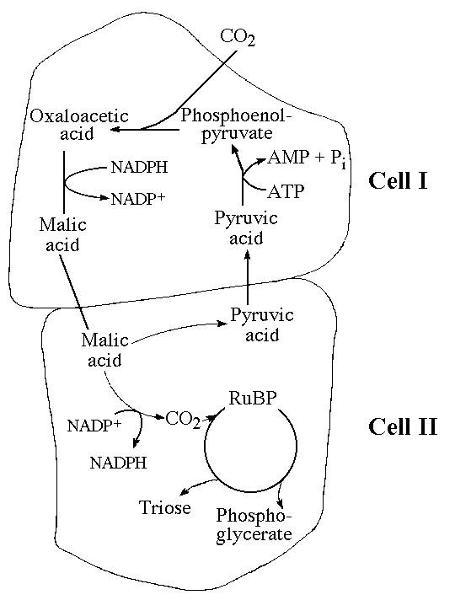
90) Which of the following statements is true concerning the accompanying figure?
A) It represents a C4 photosynthetic system.
B) It represents an adaptation that maximizes photorespiration.
C) It represents a C3 photosynthetic system.
D) It represents a CAM photosynthetic system.
A

91) Referring to the accompanying figure, oxygen would inhibit the CO2 fixation reactions in _____.
A) cell I only
B) cell II only
C) neither cell I nor cell II
D) both cell I and cell II
B
92) Photorespiration _____.
A) generates carbon dioxide and consumes ATP and oxygen
B) generates ATP and sugars and consumes oxygen and carbon dioxide
C) generates oxygen and consumes ATP, carbon dioxide, and sugars
D) consumes carbon dioxide and generates ATP, sugars, and oxygen
A
93) As a research scientist, you measure the amount of ATP and NADPH consumed by the Calvin cycle in 1 hour. You find that 30,000 molecules of ATP were consumed, but only 20,000 molecules of NADPH were consumed. Where did the extra ATP molecules come from?
A) photosystem II
B) photosystem I
C) cyclic electron flow
D) linear electron flow
C
94) What are the products of linear electron flow?
A) heat and fluorescence
B) ATP and P700
C) ATP and NADPH
D) ADP and NADP+
C
95) As electrons are passed through the system of electron carriers associated with photosystem II, they lose energy. What happens to this energy?
A) It excites electrons of the reaction center of photosystem I.
B) It is lost as heat.
C) It is used to establish and maintain a proton gradient.
D) It is used to phosphorylate NAD+ to NADPH, the molecule that accepts electrons from photosystem I.
C
96)The chemiosmotic process in chloroplasts involves the _____.
A) establishment of a proton gradient across the thylakoid
membrane
B) diffusion of electrons through the thylakoid
membrane
C) reduction of water to produce ATP
D) movement
of water by osmosis into the thylakoid space from the stroma
E)
formation of glucose, using carbon dioxide, NADPH, and ATP
A
97) Suppose the interior of the thylakoids of isolated chloroplasts
were made acidic and then
transferred in the dark to a pH 8
solution. What would most likely happen?
A) The isolated
chloroplasts would make ATP.
B) The Calvin cycle would be
activated.
C) Cyclic photophosphorylation would occur.
D)
The isolated chloroplasts would generate oxygen gas.
E) The
isolated chloroplasts would reduce NADP+ to NADPH.
A
98) The pH of the inner thylakoid space has been measured, as have
the pH of the stroma and of
the cytosol of a particular plant
cell. Which, if any, relationship would you expect to find?
A)
The pH within the thylakoid is less than that of the stroma.
B)
The pH of the stroma is lower than that of the other two measurements.
C) The pH of the stroma is higher than that of the thylakoid
space but lower than that of the
cytosol.
D) The pH of the
thylakoid space is higher than anywhere else in the cell.
E)
There is no consistent relationship.
A
99) In its mechanism, photophosphorylation is most similar to _____.
A) substrate-level phosphorylation in glycolysis
B)
oxidative phosphorylation in cellular respiration
C) the Calvin
cycle
D) carbon fixation
E) reduction of NADP+
B
100) Which process is most directly driven by light energy?
A)
creation of a pH gradient by pumping protons across the thylakoid
membrane
B) carbon fixation in the stroma
C) reduction of
NADP+ molecules
D) removal of electrons from chlorophyll
molecules
E) ATP synthesis
D
101)In plants, reduction of NADP+ occurs during _____.
A)
photosynthesis
B) respiration
C) photosynthesis and
respiration
D) neither photosynthesis nor respiration
A